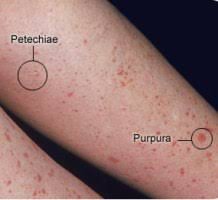 A petechia refers a small red or purple spot (≤4 mm in diameter) that can appear on the skin, conjunctiva, retina, and mucous membranes which is caused by hemorrhage of capillaries.
A petechia refers a small red or purple spot (≤4 mm in diameter) that can appear on the skin, conjunctiva, retina, and mucous membranes which is caused by hemorrhage of capillaries.
They are ≤4 mm in diameter.
It refers to one of the three
types of hematoma differentiated by size: ecchymosis (>1cm in diameter) and purpura (4-10mm in diameter).
Most commonly the cause of petechiae is physical trauma: hard bout of coughing, holding breath, vomiting, or crying, which can result in facial petechiae, especially around the eyes.
Such instances of petechiae are harmless and usually disappear within a few days.
When excessive pressure is applied to tissue, constriction;asphyxiation petechiae occur especially in the eyes, and may also occur when excessive pressure is applied to tissue as occurs when a tourniquet is applied to an extremity or with excessive coughing or vomiting.
Low platelet counts or impaired platelet function can give rise to petechial spots.
Clotting factor deficiencies- Von Willebrand disease can cause petechiae.
Petechiae seen with:
Hypocalcemia
Idiopathic thrombocytopenic purpura
Coeliac disease
Aplastic anaemia
Lupus
Kwashiorkor or Marasmus – Childhood protein-energy malnutrition
Erythroblastosis fetalis
Henoch–Schönlein purpura
Kawasaki disease
Schamberg disease
Ehlers–Danlos syndrome
Sjögren syndrome
Vasculitis,
Radiation
Fat embolism syndrome
Infectious conditions:
Babesiosis
Bolivian hemorrhagic fever
Boutonneuse fever
Chikungunya
Cerebral malaria
Congenital syphilis
Crimean–Congo hemorrhagic fever
Cytomegalovirus
Dengue fever
Dukes’ disease
Ebola
Endocarditis
Influenza A virus subtype H1N1
Hantavirus
Infectious mononucleosis
Marburg virus
Neisseria meningitidis
Rocky Mountain spotted fever
Scarlet fever
Typhus
Streptococcal pharyngitis
